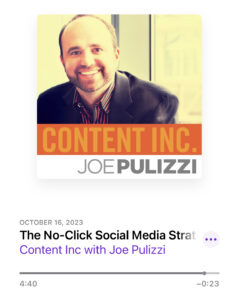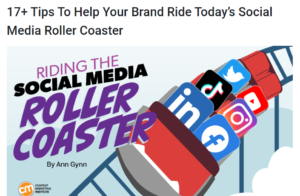
An article from Axios cites:
“Traffic referrals to the top global news sites from Meta’s Facebook and X, formerly Twitter, has collapsed over the past year, according to data from Similarweb.”
A chart in the article shows Twitter referrals declining from nearly 80 million in January 2021 to 22.6 million around July 2023. Twitter is driving less traffic to websites. And guess what? It might be punishing users who share links in the first place.
I listened to an episode of Joe Pulizzi’s “Content Inc.” podcast titled “The No-Click Social Media Strategy.”

The “No Link Social” World We Live In
Joe says that there’s still an opportunity to leverage social, but without links. The goal of all social platforms is to keep you on their site. Links take you away from their site. Says Joe:
“If you leave consistent and compelling thoughts on these platforms without linking to anything, you’re generally rewarded. If you link to anything, you will be punished and literally get no visibility.”
Joe is trying not to link to anything for the time being. I think we’re living in a “no link social” world.
In trying this out on X, he found that once he posts something with a link, all of his tweets get less exposure. In other words, it seems that Twitter punishes him (i.e., at the account level) for posting a link.
Now let that link in (bad joke related to Elon and the sink ;-).
One Simple Tactic to Try
Here’s a simple experiment using expert roundup blog posts. The idea behind expert roundup posts is to crowdsource content around a topic. In this example from Content Marketing Institute, the question posed to experts was:
How do you update your social media strategy with all that’s happening? Do you even need to change it?
 They reached out to 17+ experts and published an article titled “17+ Tips To Help Your Brand Ride Today’s Social Media Roller Coaster.” (I was honored to be included)
They reached out to 17+ experts and published an article titled “17+ Tips To Help Your Brand Ride Today’s Social Media Roller Coaster.” (I was honored to be included)
Pretend that this is an article you published.
Here’s how you can employ a no-click social media strategy with it.
- Create an image for each of the 17+ experts (e.g., name, title and headshot)
- Schedule a tweet for each expert’s advice (i.e., summarize the insight into a tweetable length)
- If the expert maintains an active account on Twitter, tag that expert in the tweet
Spread these out over 1-2 months. Do NOT link to the article. You now have 17+ tweets that just might be your best-performing social posts of the quarter.
The algorithm will reward you for not using a link, which means your audience is more likely to see it. And then comment on it. The expert you tagged is likely to repost it.
Also, heeding Joe’s observation of sharing ANY links, be sure not to include links in any of your other tweets during this time. After you assess how this experiment worked, you can try using links again and measure the impact of doing so.
Let me know how it goes!
Author: Dennis Shiao, Founder of Attention Retention.
Photo credit: Travis Saylor at Pexels.
